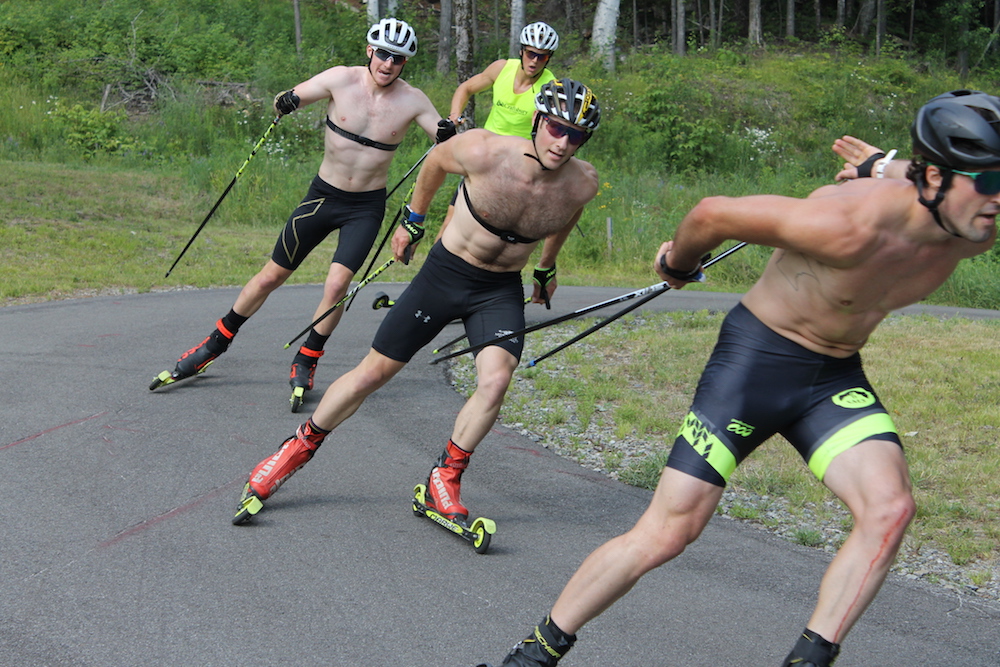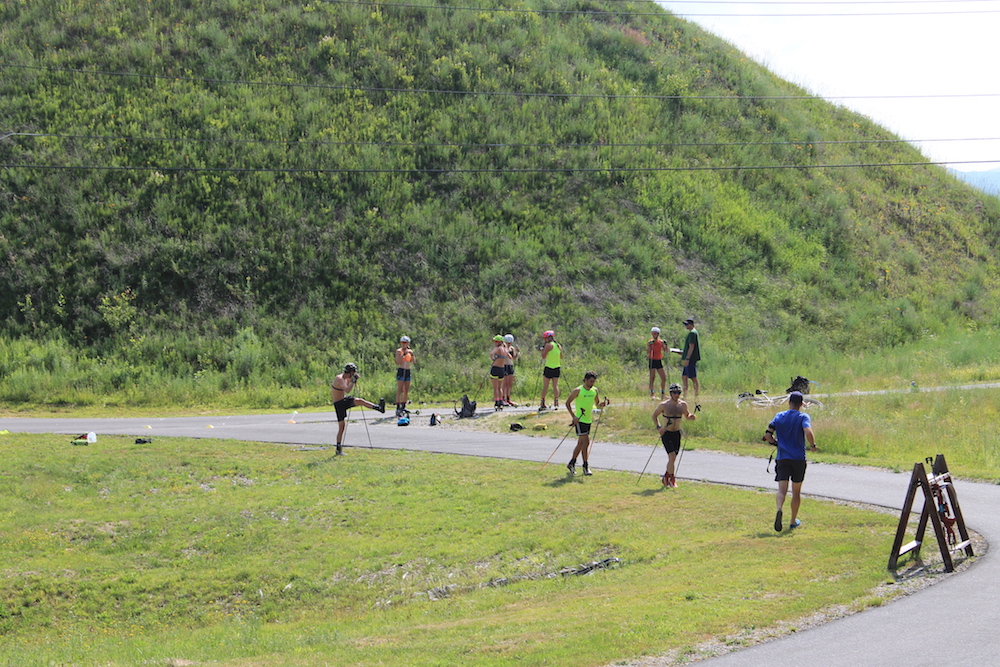
LAKE PLACID, N.Y. — This past Sunday, July 15, FasterSkier visited the U.S. women’s cross-country team in Lake Placid, where the team has been holding a dryland camp since July 11. Most all of the team’s top athletes are there — sans those that train with Alaska Pacific University (they’ll largely stick to Anchorage and nearby Eagle Glacier for summer training) — for a “semi-intensity focused” camp that will last through Friday, July 20. Their training has included everything from rollerski speed work to ski walking/bounding, over-distance trail running/hiking and point-to-point distance rollerskiing. And they’ve held several workouts with the US Biathlon team, which is based in Lake Placid.
Meanwhile, four members of the U.S. men’s team (Erik Bjornsen, Simi Hamilton, Ian Torchia, and Paddy Caldwell) have been in Villard-de-Lans, France, for a camp following the wedding of Bjornsen and Marine Dusser. Their overseas training, which has also included some “incredible trail/mountain running,” as head coach Chris Grover explained, wraps up today.
“The weather has been fantastic so far; warm and dry during the days and cool at night,” Grover wrote in an email on July 9, the first full day of camp.

In Lake Placid on Sunday, it was a warm yet breezy day for a freestyle team sprint, with temperatures reaching the 80s by late morning. Asked how many times a year the U.S. team practices team sprints, complete with each member of a two-person team racing three laps apiece, U.S. coach Matt Whitcomb said they did so about twice a year: once in mid-summer and again in October.
(On the World Cup circuit, team sprints are only held a couple of times each winter. This coming winter, a freestyle team sprint — the event Kikkan Randall and Jessie Diggins won at the 2018 Olympics — is on the schedule at 2019 World Championships in Seefeld, Austria.)
“We’ll do a formal team sprint like this a couple times a year,” Whitcomb said. “It’s obviously a huge opportunity for us with the sprint depth that we have, for both men and women, and it’s just a fun way to have a super-hard workout in a camp environment.”

Sunday’s training group included 11 women, including Diggins, Sophie Caldwell, Ida Sargent, Julia Kern, and Katharine Ogden from the U.S. Ski Team, and several others from the Craftsbury and Stratton programs, and six men (Ben Saxton, Ben Lustgarten, Akeo Maifeld-Carucci, Kyle Bratrud, Adam Martin, and Karl Schulz). The course, which was held on the Olympic Jumping Complex rollerski loop, was about 1.3 kilometers for the women and 1.7 k for the men (taking about 3 minutes per lap for the women and 3:40 for the men).
“Goal number 1 is to keep it safe and make sure we’re not having needless injuries, checking the equipment and making sure the athletes’ bindings are all working … ,” Whitcomb said. Sunglasses and helmets were mandatory. “And then secondly, just creating an environment that gives them a perception by the time they hit winter or the first team sprint on the World Cup that they’ve done this. When you feel that you’ve had experience, even if it’s because of a workout in July and one in October, you can draw a lot of confidence from that. While it is just a total 20 minutes of ‘on’ time today, it has much greater value than just that.”
“When you feel that you’ve had experience, even if it’s because of a workout in July and one in October, you can draw a lot of confidence from that.” — Matt Whitcomb, U.S. Ski Team coach
Athletes were selectively partnered in an effort to make for a “stimulating event”, Whitcomb explained. At times, they were instructed to leave the tag zone early before their teammate arrived to make for a more competitive event. The workout started with a semifinal round of head-to-head racing, followed by about a half-hour break, then finals. Due to lower numbers, the men did not compete as teams and instead raced each lap together, then took about an equal amount of rest before the second and third intervals.

For coaches and athletes wanting to replicate this workout, Whitcomb said you don’t have to have a ton of athletes and a car-free, challenging rollerski loop like the one at the Olympic Jumping Complex.
“Some days you only have three athletes and you might just have a one-mile strip of road that works and you can’t do a loop,” he said.
The U.S. team has held similar team-sprint sessions with just five or six women.
“We’ll just run it like an interval session,” he said. “We simulate it and you even have a tag zone, but you don’t have a teammate. We might simulate a race situation where somebody’s partner broke a pole and we’ll make them wait for five extra seconds or something like that.”
On a point-to-point course, it might take a little more time to get back to the start, “but it gives the athletes what you’re looking for,” Whitcomb said.

He also recommended getting creative and having fun with the workout.
“Sometimes the ladies are making decisions on their own; they’ve got a good idea of what makes a great workout,” Whitcomb said. “There were a couple times where our PA, start-finish guy, Gus [Kaeding], who was also our creativity manager today, came up with some interesting situations, like somebody had slow skis that lap so [their partner] had to wait a little bit. For the men, they were running it more interval-style where they sent Kyle [Bratrud] out as a rabbit for Ben [Saxton] and Ben [Lustgarten] to chase down and that made it really exciting and stimulating for them.”
The workout takes close to two hours to complete so plan the start time accordingly. The U.S. coaches moved the start of the women’s final up slightly to try to beat the heat.
“In hindsight we probably would have started a little bit earlier,” Whitcomb said. “It’s hot out here today and it’s something you have to watch out for in the summer. If it’s excessively hot, we won’t run this workout because you start to lose the benefit. … But today was reaching 80 and happened to be humid, but it was manageable.”
Coaches also took lactate readings of all participating athletes immediately after they finished their final laps of both the semifinals and finals.
buy clomid online, buy yasmin online
Team sprint start times (as outlined by the U.S. Ski Team for its July 15 workout. These changed slightly during the session):
9:30 a.m. Men’s semifinal (3 laps of 1.7 k with about 4 minutes of rest in between)
10 a.m. Women’s semifinal (3 laps of 1.3 k with about 3 minutes of rest in between)
10:30 a.m. Men’s final (Same format as men’s semifinal)
11:00 a.m. Women’s final (Same format as women’s semifinal)
The U.S. women’s and men’s teams also have upcoming training camps planned for New Zealand (three weeks in late August/early September) and Park City, Utah, in October.


Alex Kochon
Alex Kochon (alexkochon@gmail.com) is a former FasterSkier editor and roving reporter who never really lost touch with the nordic scene. A freelance writer, editor, and outdoor-loving mom of two, she lives in northeastern New York and enjoys adventuring in the Adirondacks. She shares her passion for sports and recreation as the co-founder of "Ride On! Mountain Bike Trail Guide" and a sales and content contributor at Curated.com. When she's not skiing or chasing her kids around, Alex assists authors as a production and marketing coordinator for iPub Global Connection.



